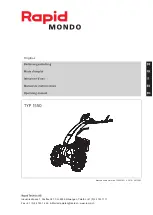
22
EN
ENGLISH
EN
Protect against humidity
Never expose tool to rain.
Switch the appliance off and remove the
contact key before any adjustment, clea-
ning and servicing work.
Caution, risk of drawing-in
Protection class III
CE marking
Any damaged or disposed electric or
electronic devices must be delivered to
appropriate collection centres.
Guaranteed sound power level L
WA
Battery
For an optimum life-time, the
battery packs have to be fully
charged, after used.
Battery to be used at the ambient tempe-
ratures between 10°C and +40°C only.
Protect the battery against heat and fire.
Protect the battery against water and
moisture.
MAX 40°C
Protect the battery against temperatures
above 40°C.
Direct Current
Any damaged or disposed electric or
electronic devices must be delivered to
appropriate collection centres.
Li-Ion
Do not throw the batteries in household
waste.
Deliver the batteries to a collection centre of
old batteries where they will be recycled in
an environmentally friendly way.
General Power Tool Safety Warnings
WARNING
Read all safety warnings and all instructions.
Failure
to follow the warnings and instructions may result in
electric shock, fire and/or serious injury.
Save all warnings and instructions for future
reference.
The term „power tool“ in the warnings refers to your
mains-operated (cordepower tool or battery-opera-
ted (cordless) power tool.
1) Work area safety
a)
Keep work area clean and well lit.
Cluttered or
dark areas invite accidents.
b)
Do not operate power tools in explosive atmo-
spheres, such as in the presence of flammable
liquids, gases or dust.
Power tools create sparks
which may ignite the dust or fumes.
c) Keep children and bystanders away while opera-
ting a power tool. Distractions can cause you to
lose control.
2) Electrical safety
a)
Power tool plugs must match the outlet. Never
modify the plug in any way. Do not use any
adapter plugs with earthed (groundepower
tools.
Unmodified plugs and matching outlets
will reduce risk of electric shock.
b)
Avoid body contact with earthed or grounded
surfaces, such as pipes, radiators, ranges and
refrigerators.
There is an increased risk of electric
shock if your body is earthed or grounded.
c)
Do not expose power tools to rain or wet con-
ditions.
Water entering a power tool will increase
the risk of electric shock.
d)
Do not abuse the cord. Never use the cord for
carrying, pulling or unplugging the power tool.
Keep cord away from heat, oil, sharp edges or
moving parts.
Damaged or entangled cords
increase the risk of electric shock.
e)
When operating a power tool outdoors, use an
extension cord suitable for outdoor use.
Use of
a cord suitable for outdoor use reduces the risk of
electric shock.
f)
If operating a power tool in a damp location
is unavoidable, use a residual current device
(RCprotected supply.
Use of an RCD reduces the
risk of electric shock.
3) Personal safety
a)
Stay alert, watch what you are doing and use
common sense when operating a power tool.
Do not use a power tool while you are tired or
under the influence of drugs, alcohol or medi-
cation.
A moment of inattention while operating
power tools may result in serious personal injury.
b)
Use personal protective equipment. Always
wear eye protection.
Protective equipment such
as dust mask, non-skid safety shoes, hard hat, or
















































